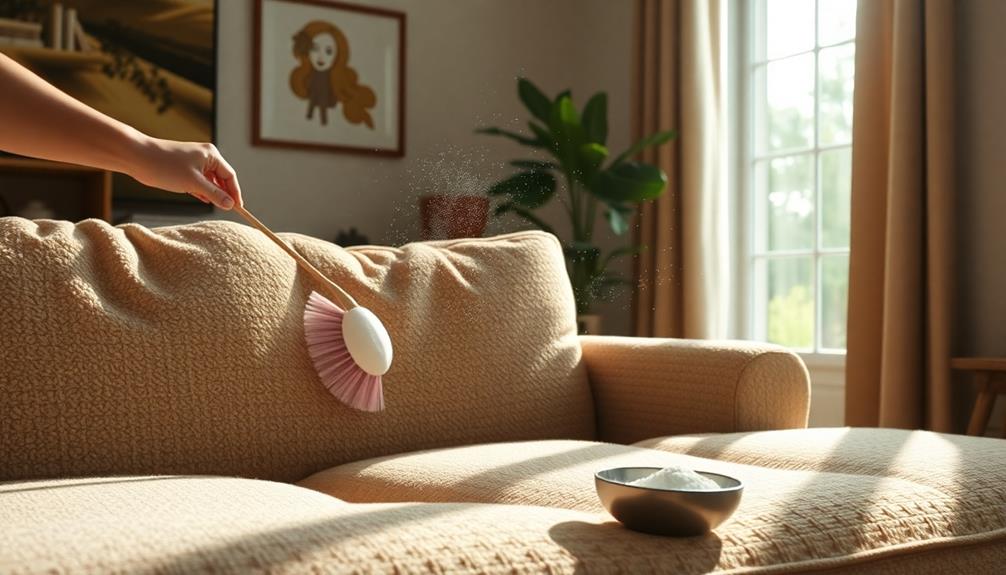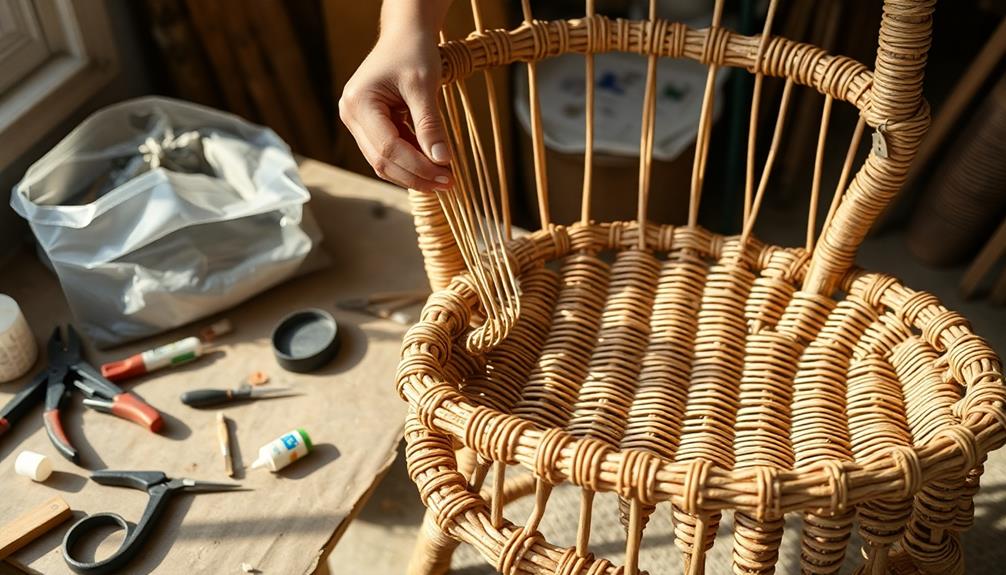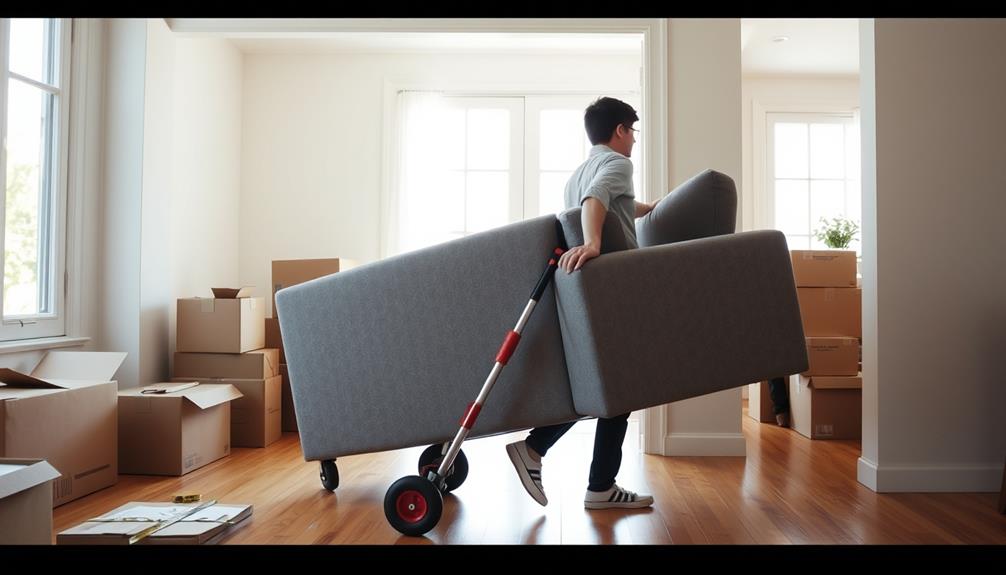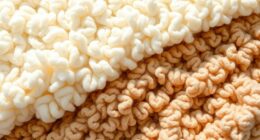To properly clean your sofa using baking soda, the first step is determining the fabric type for optimal results. Take out the cushions and thoroughly vacuum to get rid of any dust and pet hair. Then, generously sprinkle baking soda all over the sofa. Gently brush it into the fabric and let it sit for at least 20 minutes to eliminate odors. Finally, vacuum the sofa one more time to ensure all baking soda residue is removed. This method not only freshens up your couch but also helps maintain its quality. For more helpful tips and techniques, feel free to explore additional resources.
Key Takeaways
- Remove cushions and vacuum the entire sofa to eliminate dirt, dust, and pet hair before applying baking soda.
- Sprinkle a generous layer of baking soda over the couch and work it into the fabric with a soft brush.
- Allow baking soda to sit on the couch for at least 20 minutes to effectively absorb odors.
- Vacuum thoroughly after the resting period to remove all baking soda and any absorbed smells.
- Regularly apply baking soda every 6-12 months to maintain freshness and prevent odors.
Identify Couch Material
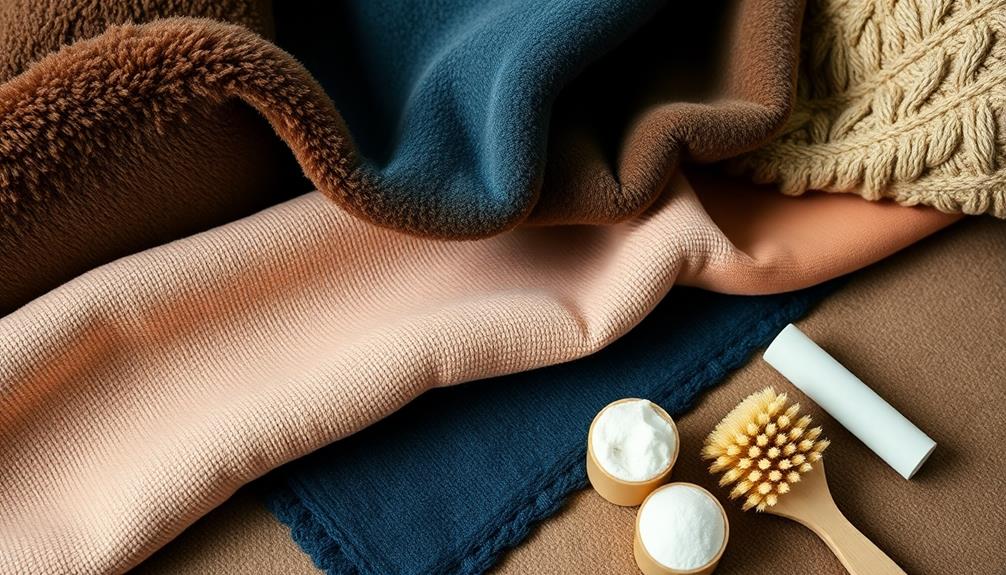
When cleaning your sofa, the first step is to identify its material. This is essential because different fabrics require specific cleaning methods. For instance, leather needs gentle cleaners, while microfiber is generally water-resistant. To determine your couch's material, check the fabric care tag, which often provides valuable cleaning instructions.
If you have a leather couch, use a damp microfiber cloth for routine cleaning and apply a conditioner every 6-12 months to keep it soft and prevent cracking.
Microfiber couches can be cleaned effectively with rubbing alcohol, which helps remove stains without water damage.
If you own a fabric couch, you'll want to take into account deodorizing with baking soda, followed by a mixture of water and dish soap for spot cleaning. After spot cleaning, allow the fabric to air dry completely. For tougher stains, you may need to repeat the cleaning process or consider learning the **steps to bleach furniture**, but be cautious as bleach could damage the fabric. Always perform a patch test on a small, hidden area before applying any strong cleaning agents. For more delicate fabrics, it’s best to avoid using harsh chemicals and opt for gentle cleaning solutions. If you’re dealing with wood accents on your couch, you might also be interested in learning **how to bleach wooden furniture** safely, as it can restore its natural look without causing damage. Be sure to research proper techniques and products specifically designed for wood to avoid any unintended discoloration or wear.
Cotton upholstery is comfortable but can stain easily, making it necessary to either treat spots carefully with the right cleaning solutions or seek professional upholstery cleaning.
Prepare for Cleaning
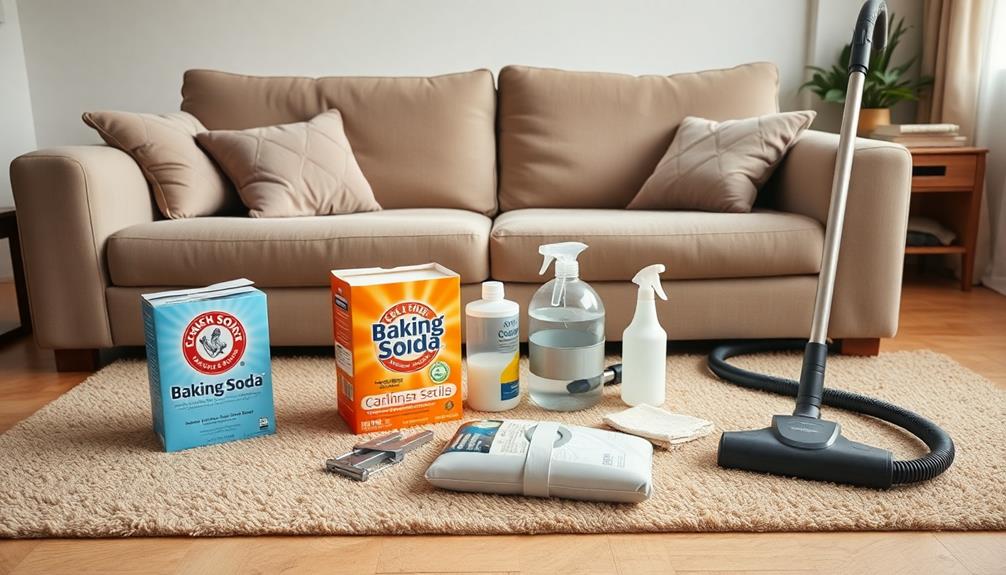
Now that you've identified your couch's material, it's time to prepare for cleaning. Start by removing all removable cushions and setting them aside. This gives you easier access to the entire surface, making the cleaning process more effective.
Use a hand-held vacuum or an upholstery attachment to thoroughly vacuum the couch. Focus on eliminating dirt, dust, and pet hair from the fabric, ensuring you reach every crevice and beneath the cushions. For ideal cleaning, consider the benefits of using non-toxic cleaning solutions, as suggested in home remedies for various cleaning tasks.
Next, take a moment to check the couch for any stains or spots. If you find any, note them down, as they may require special pre-treatment before applying baking soda. This step is essential for achieving the best results in your cleaning process.
Apply Baking Soda
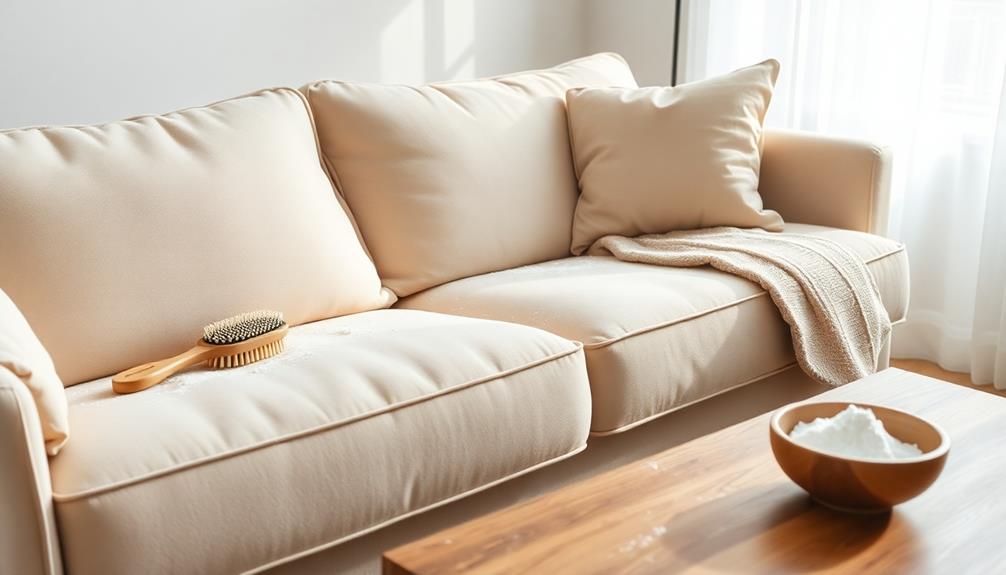
Applying baking soda is a simple yet effective way to freshen up your sofa and eliminate odors. Start by spreading a generous layer of baking soda evenly over the entire surface of the couch and all cushions. This guarantees you maximize odor absorption.
Many people also find that using natural remedies, like baking soda, complements conventional cleaning methods for a fresher home environment natural remedies for cleaning.
Here's how to do it right:
- Cover Every Surface: Confirm you cover both sides of removable cushions with baking soda for complete odor elimination.
- Gently Work It In: Use a clean, soft bristle brush to work the baking soda into the fabric. This enhances its effectiveness against odors.
- Let It Rest: Allow the baking soda to sit on the fabric for at least 20 minutes, or up to 1 hour for stronger odors. This gives it ample time to absorb.
- Vacuum Thoroughly: After the resting period, vacuum the couch thoroughly to remove all baking soda residue and any absorbed odors.
Allow for Odor Absorption

Give your baking soda time to work its magic by allowing it to rest on your sofa's fabric. For effective odor absorption, let it sit for at least 20 minutes. If you're dealing with particularly strong smells, consider extending this time to over an hour.
The longer the baking soda remains on your couch, the better it can neutralize and absorb odor-causing substances, thanks to its mild alkali properties.
During the resting period, keep an eye on the couch to check for any lingering odors. If you still notice unwanted smells, don't hesitate to let the baking soda stay longer. This simple cleaning solution is incredibly effective when given adequate time to perform its task.
Once the absorption period is over, make sure to thoroughly vacuum the baking soda from your sofa. This step is essential to prevent any residual powder from sticking to the fabric.
For the best results, try incorporating baking soda into your regular cleaning routine every 6-12 months. This will help keep your couch smelling fresh and inviting, making it a comfortable spot for you and your guests.
Vacuuming Process
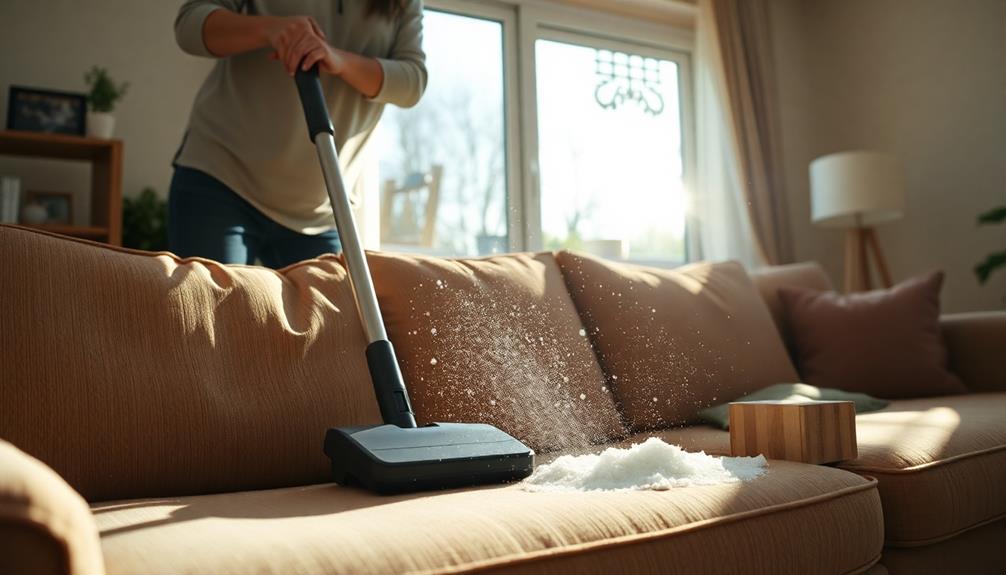
When you're ready to vacuum your sofa, grab a hand-held vacuum or an upholstery attachment for the best results.
Consider using a model from the Best Vacuums for Dust Removal in 2024 for superior performance in eliminating allergens.
Make certain you cover every inch, especially in the crevices and seams where dirt and baking soda like to hide.
After vacuuming, double-check for any leftover residue to confirm your couch is spotless.
Proper Vacuuming Techniques
Effective vacuuming is essential for keeping your sofa clean and fresh. By mastering proper techniques, you can effectively remove baking soda and dirt, guaranteeing your couch looks and feels great.
Regular maintenance can help prolong the life of your furniture, similar to how preventive maintenance can extend appliance lifespan considerably.
Here's how you can enhance your vacuuming process:
- Use the Right Tools: Opt for a hand-held vacuum or an upholstery attachment. This helps you get into those tricky spots with ease.
- Focus on All Surfaces: Don't forget to vacuum under the cushions and in crevices. These areas often harbor hidden dirt and baking soda.
- Check for Residue: After vacuuming, run your hands over the fabric to feel for any leftover baking soda. If you notice any, repeat the vacuuming process.
- Maintain Your Equipment: Regularly clean your vacuum's filter and brush. A well-maintained vacuum guarantees strong suction, lifting embedded dirt and baking soda effectively.
Ensuring Thorough Coverage
After mastering proper vacuuming techniques, it's important to confirm you cover every inch of your sofa. Start by using a hand-held vacuum or an upholstery attachment to remove baking soda evenly from the entire surface. Focus on both the couch and the cushions, confirming you pick up any dirt particles that the baking soda absorbed during the cleaning process.
Additionally, keeping a budget for home maintenance can help you prioritize cleaning supplies and services as needed, which is essential for maintaining your living space's comfort and appearance financial health.
Pay special attention to the crevices and seams—these areas can easily be overlooked but often hide leftover baking soda. If you notice any spots that still seem dusted, don't hesitate to vacuum those areas again. Visual inspections are key; after your initial pass, check for any remaining residue that may linger.
Once you're satisfied with your vacuuming, replace all cushions back to their original positions. This not only enhances your couch's appearance but also maintains its comfort.
If you find the task overwhelming, consider hiring a professional cleaning service to confirm thorough coverage. However, with careful attention, you can achieve a deep clean that leaves your sofa fresh and inviting.
Checking for Residue
Checking for residue is a crucial step in the vacuuming process to guarantee your sofa is truly clean. After applying baking soda, it's important to thoroughly remove it to make certain your couch looks its best.
Regularly checking for buildup, similar to how one maintains air purifier filters, can help keep your living space fresh as well.
Here's how to effectively check for residue:
- Inspect the surface: Look closely at your sofa for any visible signs of baking soda. This can affect the overall appearance.
- Focus on crevices: Pay special attention to seams and corners where baking soda can easily accumulate and hide.
- Re-vacuum if needed: If you find any remaining residue, don't hesitate to repeat the vacuuming process until it's completely gone.
- Replace cushions: Once you're confident all baking soda is removed, return the cushions to their original positions to restore your sofa's look.
Stain Removal Techniques
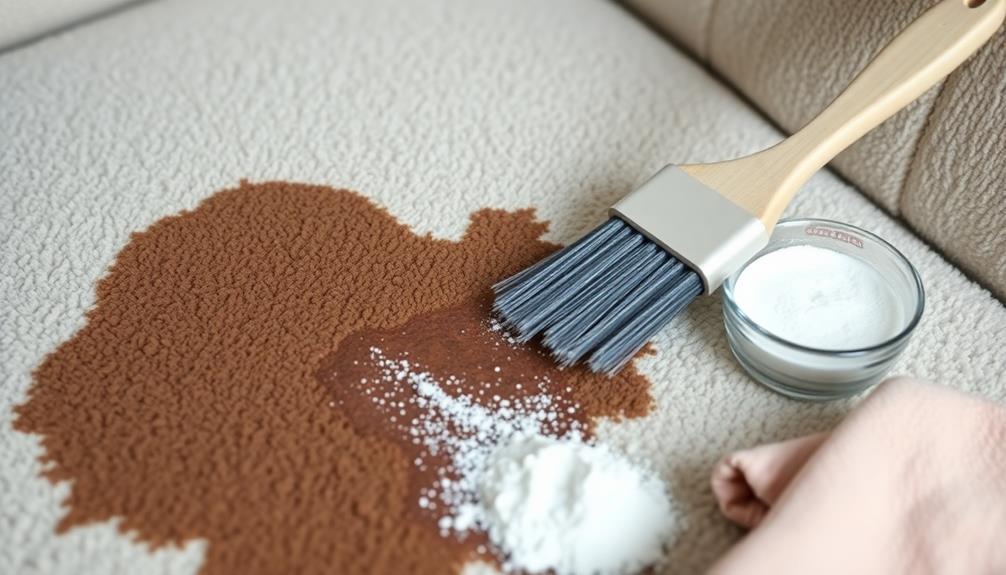
When it comes to tackling stains on your sofa, knowing the right techniques can make all the difference. For food stains, gently blot the area with a mixture of water and dish soap. Avoid rubbing, as that can spread the stain further.
For beverage spills like wine or coffee, dab the stain with a solution of vinegar and water, applying it gently to lift it without damaging the fabric. Additionally, you can use essential oils for stain removal which may help neutralize odors and enhance cleaning effectiveness.
If you're dealing with pet stains, enzymatic cleaners work wonders by breaking down odors and stains at a molecular level. For stubborn ink stains, apply rubbing alcohol to a clean cloth and blot the stain immediately to prevent it from setting.
For tougher stains, consider using a paste made from baking soda and water. Apply this paste directly to the stain and let it sit for about 30 minutes to an hour. Afterward, blot the area with a damp cloth to lift the stain away.
These techniques will help you effectively clean a couch and keep it looking fresh and inviting.
Maintain Couch Cleanliness
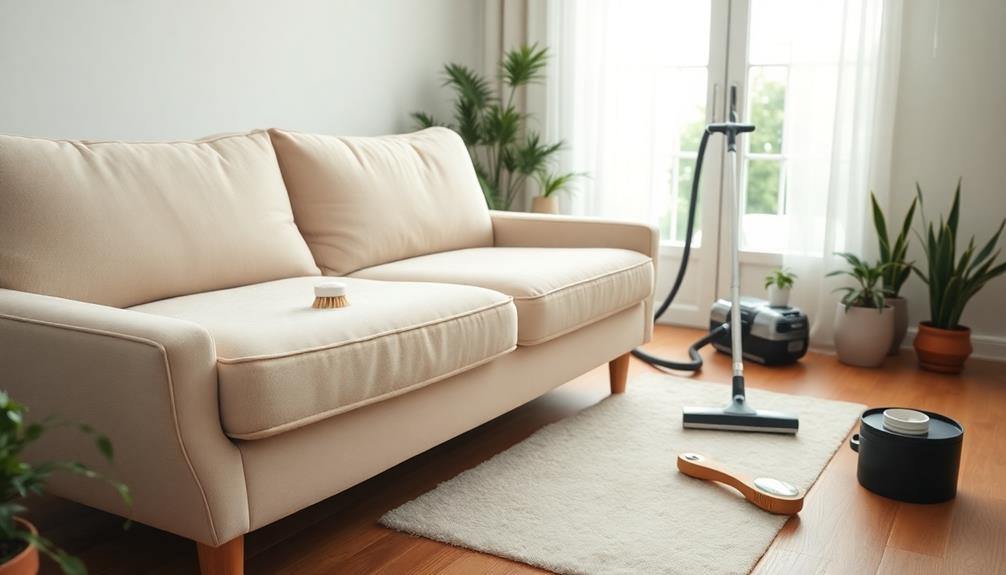
Maintaining your couch's cleanliness goes hand in hand with effective stain removal techniques. To keep your couch looking fresh and inviting, here are some essential tips you can easily incorporate into your routine:
1. Vacuum Weekly: Regularly vacuum your couch at least once a week to eliminate dust, dirt, and pet hair. This simple step prevents buildup and contributes to overall cleanliness.
Additionally, heartfelt expressions of love can help you cherish the moments spent on your couch.
2. Rotate Cushions: Every few weeks, rotate your couch cushions to promote even wear. This helps avoid permanent indentations and keeps your couch looking its best.
3. Use Protective Covers: Consider using protective throws or slipcovers. They shield your couch from spills and stains, making it easier to maintain couch cleanliness.
4. Schedule Deep Cleaning: Plan deep cleaning sessions every 6-12 months. This removes embedded dirt and refreshes the fabric, ensuring your couch remains in good condition.
Frequently Asked Questions
Can I Clean My Couch With Baking Soda?
Yes, you can clean your couch with baking soda. It absorbs odors and loosens dirt effectively. Just vacuum first, spread the baking soda, let it sit, then vacuum again for a fresh, clean sofa.
What Is the Best Way to Clean a Sofa?
So, you think cleaning your sofa's a walk in the park? First, identify your fabric, vacuum thoroughly, and then tackle stains like a pro. Regular maintenance'll keep it looking fresh, or you'll end up with a sofa crime scene!
How Long to Let Baking Soda Sit on a Couch?
To effectively absorb odors, let baking soda sit on your couch for at least 20 minutes. For stronger smells, consider extending this to an hour or more. Remember to vacuum thoroughly afterward for best results.
Can You Leave Baking Soda on Couch Over Night?
You can leave baking soda on your couch overnight, but make sure the fabric's safe first. Test a hidden spot, keep it dry, and prepare for a little extra vacuuming effort in the morning.
Conclusion
By cleaning your sofa with baking soda, you can easily keep it fresh and inviting. Did you know that a study found 80% of dust mites thrive in upholstered furniture? Regular maintenance, like using baking soda, helps reduce allergens and prolongs your couch's life. So, make this simple method a part of your cleaning routine, and enjoy a cleaner, healthier living space. Your couch will thank you, and so will your allergies!
